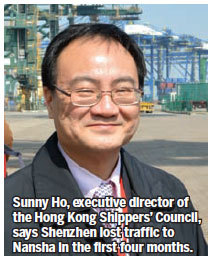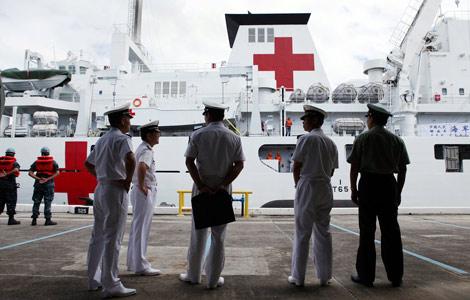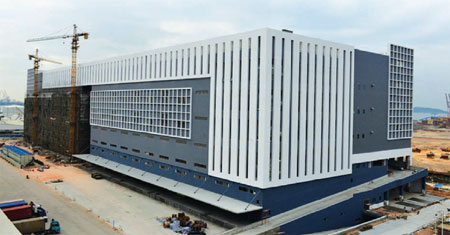Port rebounds from cutthroat competition
Updated: 2014-06-27 11:12
By Wong Joon San in Hong Kong (China Daily USA)
|
||||||||

On the surface, competition between the neighboring ports of Hong Kong and Shenzhen may not appear as intense as it really is. At the end of last year, when Shenzhen surpassed Hong Kong as the World's third busiest container port, however the alarm that was sounding throughout the local shipping industry grew more shrill. Hong Kong has struggled back, since and has been restored into third position but there is little solace to be taken.
Ports everywhere jealously guard their standing, and Hong Kong stands among the most fiercely competitive. Despite this, the port's dominance has steadily eroded. In recent years, mainland ports like Yantian, Chiwan, Shekou and Da Chan Bay Terminal One have made spectacular gains in efficiency and quality of service.
The stakes are high amid the intense competition. Ports have an enormous catalytic effect on local economies, especially, in the increasingly globalized economy. In days past, shipping lines just sailed ships and ports handled cargo. That's changed now. Container terminals and shipping lines today, are heavily invested in logistics and supply chain management. The key to their success lies in cost efficiency - and cost efficiency is the spur for cutthroat competition among ports around the globe.
Last year, the economic picture turned a shade darker for the Port of Hong Kong when it saw its standing fall below Shenzhen. The city's container port processed 22.4 million "twenty-foot equivalent units" (the standard measure for container shipping), a 3.3 percent drop from 2012. The Port of Shenzhen, just across the border, raised its throughput, 1.5 percent, to 23.28 million TEU, overtaking Hong Kong and becoming the third-busiest container port in the World. It didn't last long.
In the current environment which sees ports, unrelenting in efforts to become more attractive to major shipping lines, no sooner had Shenzhen declared itself "Number Three" before business began slipping away.
"From January through April, Shenzhen lost container traffic to (neighboring) Nansha, which had made a "better" offer to the Danish shipping carrier Maersk, on terminal fees," said Sunny Ho, executive director of the Hong Kong Shippers' Council.
Ho stressed, the move was no surprise. "Finding low cost solutions is an ongoing fixation with shipping lines," said Ho. They're always looking for a better deal, especially on terminal charges paid to port operators.
Maersk has bounced around from port to port for years. Back in August, 2000, when the company was called Maersk Sealand, it pulled out of Singapore and moved to the Port of Tanjung Priok, in Malaysia. Taiwan's Evergreen Line wrapped up its Singapore operations around the same time, and moved its Southeast Asian, westbound service to Thailand's Laem Chabang terminal.
The circumstances of Hong Kong's reinstatement to the Number Three post among global container ports haven't solved the problems that caused the fall in the first place.
There's still not enough overflow storage at the port's Kwai Tsing Container Terminals. It's a problem that's been around for years, but the 2008 financial crisis set off a polar shift in the business climate that made things worse. Direct container business to the US and Europe actually dropped. It never actually recovered from 2008. The Port of Hong Kong shifted focus from direct shipment, to transshipment, almost as a matter of "survival". Instead of shipping directly these days, Hong Kong imports products, practically from everywhere, including the mainland, then stores them until they are ready to be transshipped to overseas destinations. The storage may be for days, or for weeks. It may even be for months. Longer storage means more space is needed.
Head out to the New Territories and you'll see shipping containers scattered all over the place, on every conceivable plot of land: abandoned farms, parking lots, private beaches - anywhere a container can be put down.
The Hong Kong Container Terminal Operators Association (HKCTOA) has lobbied the government to assure adequate container storage, by making better use of land near the port. HKCTOA chairman Jessie Chung told China Daily, that although more than 100 hectares in the port's vicinity have been designated by the government for storage of containers, in fact, a great proportion is used for other purposes, including uses not directly related to the port. The association also wants the government to accommodate growing shipments by barge.
"There has been a 30-percent increase in Pearl River Delta barge traffic, over the past ten years, involving goods for transshipment overseas. That means a significant increase in demand for barge berths," Chung said.
Despite the increased demand, land allocation in Hong Kong has fallen significantly behind other major parts. The port was constructed on a ratio of 14 hectares for every 400 meters of berth. Today's international standard is 75 percent higher: 25 hectares per 400 meters of berth.
Congestion at berthing and storage facilities, during peak times has been exacerbated as larger and larger ships ply the world's oceans. The bigger ships can carry more containers, giving them, in theory, economy of scale over smaller vessels. In practice, however, economies have scale have not been achieved and the big ships actually have contributed to congestion in the port. One mega-ship occupies berthing space sufficient to accommodate two smaller ships. With shipments to US and European markets way down, the big ships frequently have to wait for incoming cargo, still in transit, before they can be fully loaded and be underway. That compounds congestion.
Kwai Tsing Container Terminals handled over 17 million TEU in 2013. It employs 8,000 workers generating a multiplier effect believed, conservatively to support 32,000 indirect jobs.
There is also a shortage of truck drivers for which the HKCTOA has blamed licensing regulations. Policies like this that obstruct the flow of business operations must be reviewed, Chung told China Daily. "The government can protect the port's highly significant contribution to Hong Kong's economic and social development, by addressing these issues," she declared.
HKCTOA has cited these issues as critical to improving productivity at the port and maintaining its competitive position, in a White Paper submitted by the HKCTOA to the government, last November.
The White Paper, outlining challenges facing the port and laying out timelines for redevelopment has won support from shipping lines, industry associations and logistics operators. All agreed that if the proposals are put into effect, their operations will benefit and the port will maintain its competitive position.
Among the recommendations was a call for the reservation of specific sites totaling some 70 hectares for backup storage. An additional 30 hectares not required for port expansion, would continue serving independent operators of container storage facilities and as parking space for trucks.
Hong Kong Trade Development Council's economist, for global research, Wenda Ma projected in a separate report that container throughput will undergo modest but steady growth over the next few years. The report added however that Hong Kong will need to construct a 10th terminal by 2015, a deadline scoffed by some industry critics.
The government is conducting a study to examine the technical feasibility and environmental impact of constructing Container Terminal 10 (CT10) at Southwest Tsing Yi.
joonsan@chinadailyhk.com
|
Shenzhen warehouse space attracts plenty of interest. |
(China Daily USA 06/27/2014 page7)
- Illegal drugs go up in smoke in Guangdong
- PLA vessels join Pacific naval drill for the first time
- Relatives unmoved by new search zone for jet
- Hebei envisions integrated traffic network by 2020
- 3D paintings entertain people in Hong Kong
- Officials deny planning to turn 600 colleges into senior vocational schools

 Germany, US sail into knockout stages in Recife rain
Germany, US sail into knockout stages in Recife rain
 PLA ships arrive in Hawaii for naval exercise
PLA ships arrive in Hawaii for naval exercise
 Baucus: Investment pact opens a new chapter
Baucus: Investment pact opens a new chapter
 2014 Smithsonian Folklife Festival kicks off in DC
2014 Smithsonian Folklife Festival kicks off in DC
 Germany vs USA - The battle of two masterminds
Germany vs USA - The battle of two masterminds
 Apple to launch bigger iPhones to reignite sales
Apple to launch bigger iPhones to reignite sales
 Xunlei IPO on Nasdaq raises $88m
Xunlei IPO on Nasdaq raises $88m
 Beijing, Boston are just 13 hours apart
Beijing, Boston are just 13 hours apart
Most Viewed
Editor's Picks
|

|

|

|

|

|
Today's Top News
Alibaba plans to list shares on NYSE
Top hospitals abroad target nation's rich
PLA vessels join Pacific naval drill for the first time
Pentagrams on tower of babel
Recycling tycoon criticized for charity event in NY
Envoy rejects a 'zero-sum' strategic race
Chen Guangbiao's charity event provides lunch, no cash
Google unveils new products
US Weekly

|

|







